
Schlumberger is an oil services exploration company founded in 1926. The company started providing geophysical mapping services. Today it has grown to having a market cap of $54.59 billion and average trading volume of $13.2 million shares per day. It has a physical presence in 120 countries around the world. Schlumberger helps the upstream energy players to locate oil and gas, and to drill and evaluate hydrocarbon wells.
The entire oil sector was hit hard by the pandemic and economic lockdown two years ago. During the start of the pandemic $SLB stock fell sharply from $41 per share all the way down to $11.87. Now, two years later as countries are recovering and discarding their pandemic restrictions, the demand for oil and gas has never been higher. Schlumberger is perfectly positioned for this increased demand in oil.
Over the last year, $SLB has increased in value by 49.62% trouncing the S&P 500 which only gained 14%. As the world returns to the very real need of fueling planes, and automobiles as well as heating homes, in spite of the reality that oil is trading at 7-year highs, $SLB is tasked with the mission of drilling new wells and increasing the oil flow from existing wells.
For the last several months we have written how we think Oil may be in a bull market that could last many, many years. With inflation also trading at 40-year highs this positions $SLB very well for increased profit margins in the months and years ahead.
$SLB has a digital division of the company which utilizes neural networks and machine learning to improve their electronic geophysical mapping for exploration purposes. This division uses a software called DELFI that now boasts over 240 commercial customers and is growing at 160% user growth year over year and is responsible for 13% of their annual revenues. Even in the oil and gas sector, artificial intelligence has proven superior at finding proven reserves and extracting more from existing reserves.
Headlines like the following have been responsible for the solid gains that $SLB has made in recent weeks, and we think bode very well for its long-term future.


High inflation and high Crude prices are very tightly correlated, and we think this trend is only beginning. We think this sector is potentially explosive in the months ahead.
In this weekly stock study, we will look at and analyze the following indicators and metrics as are our guidelines which dictate our behavior in deciding whether to buy, sell, or stand aside on a particular stock.
- Wall Street Analysts’ Estimates
- 52-week high and low boundaries
- Best Case – Worst Case Analysis
- Vantagepoint A.I. Forecast (Predictive Blue Line)
- Neural Network Forecast
- Bollinger Bands Analysis
- Daily Range Forecast
- Intermarket Analysis
- Our Suggestion
We don’t base our decisions on things like earnings or fundamental cash flow valuations. However, we do look at them to better understand the financial landscape that a company is operating under.
Analysts Ratings
The first set of boundaries which we explore in our stock study is what do the professionals think who monitor the stock for a living. We can acquire this information by simply looking at the boundaries that the top Wall Street Analysts set for $SLB. This initial set of boundaries provides us with an idea of what is expensive, fairly valued, and cheap.
Based on 15 Wall Street analysts offering 12-month price targets for Schlumberger in the last 3 months. The average price target is $44.00 with a high forecast of $48.00 and a low forecast of $42.00. The average price target represents a 13.11% change from the last price of $38.90.
From this simple analysis we can see that $SLB is undervalued at present time but some on Wall Street think that is has the potential to run to as high as at least 10% higher.
52-week High-Low Chart
Where the rubber meets the road as far as analysis is concerned is looking at the charts and evaluating where the asset stands in relation to its 52-week highs. As counterintuitive as it may sound, great stocks tend to consistently make new 52-week highs.
One of the simplest ways to evaluate a stock is to look at some long term monthly and weekly charts to be able to zoom out and see the big picture of the trend. Some of the greatest traders in the world use the longer-term monthly charts to determine trend analysis.
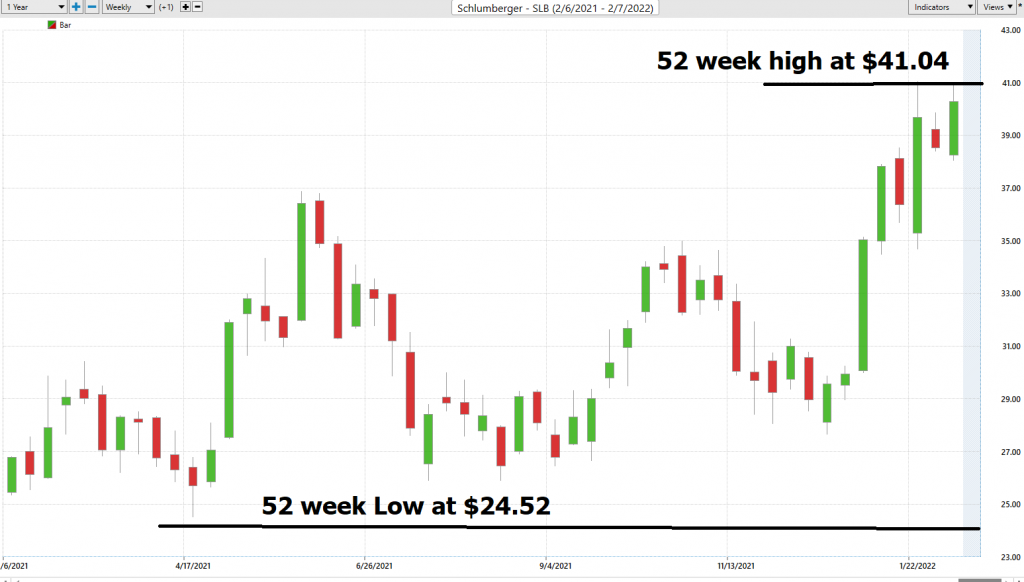
Whenever we trade, we always pay attention to where we are in relation to the 52-week trading range. It is very common to see the 52-week high provide very strong resistance to the market until it is breached. Often when the 52-week high is breached we will see the stock price explode higher very quickly over a very short period.
$SLB continues to make new 52-week highs. Over the last 5 weeks, like many stocks in the oil and gas sector $SLB has made a new 52 week high on 4 of those weeks and has rallied an additional 10%.
The 52-week boundary often acts as significant resistance in thwarting trends. As price bounces off this level, we want to become extremely focused on what the artificial intelligence forecast is signaling.
$SLB has traded as high as $41.04 and as low as $24.52 over the last 52 weeks. Its annual trading range has been $16.51 which means that its average weekly trading range has been .31.
We also like to take the annual trading range of $16.51 and divide it by the current price of $38.90 to calculate a broad-based measure of volatility. This tells us that the current volatility is 42.44% which tells us that everything would be considered statistically normal in one year if $SLB was trading 42.4% higher or lower from current levels according to this measure.
Best Case – Worst Case Analysis
Next, we want to evaluate $SLB in comparison to the performance of the major stock market indexes which we have greater familiarity with and then look at the drawdowns of the stock over the past year to get a worst-case scenario idea for any conclusions that we might reach when we trade this asset.

Regardless how you analyze it over whatever time frame you can see that $SLB has massively outperformed the broader stock market indexes.
One of the huge secrets to picking your stocks is finding those assets which outperform all of the broader market indexes over all major important time frames. This is what has occurred in $SLB over the last year.
Rest assured that Wall Street traders and investors are also very aware of this, and they will start rotating out of the broader market indexes and into Oil stocks should a recession or high inflation continue to plague the economy.
What were the worst-case drawdowns? The graphic below shows the bumpy ride.
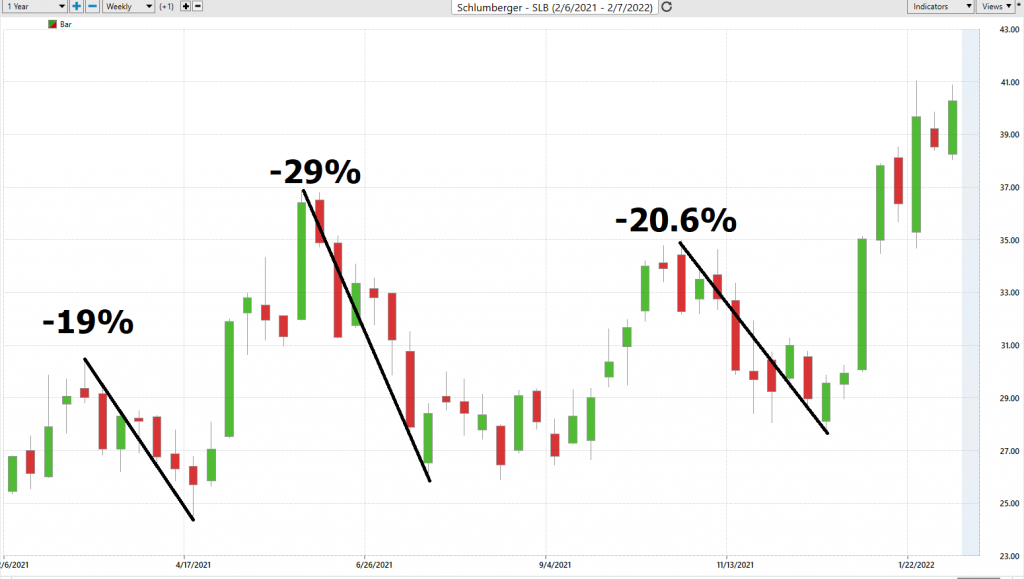
The Vantagepoint A.I. Analysis

Using VantagePoint Software and the artificial intelligence, traders are alerted to trend forecasts by monitoring the slope of the predictive blue line. The black line is a simple 10 day moving average of price which simply tells you what has occurred in the market. The predictive blue line also acts as value zone where in uptrends traders try to purchase the asset at or below the blue line.
In studying the chart below, pay close attention to the relationship between the black line and predictive blue line. All that the black line tells you is what has occurred. It tells you where prices have been and what the average price over the last ten days is.
The predictive blue line, on the other hand utilizes that Vantagepoint patented Neural Network and Intermarket Analysis to arrive at its value. It looks at the strongest price drivers of an asset through artificial intelligence and statistical correlations to determine its value.
Whenever we see the predictive blue line move above the black line, we are presented with an UP-forecast entry opportunity. These are highlighted by UP arrow on the chart.
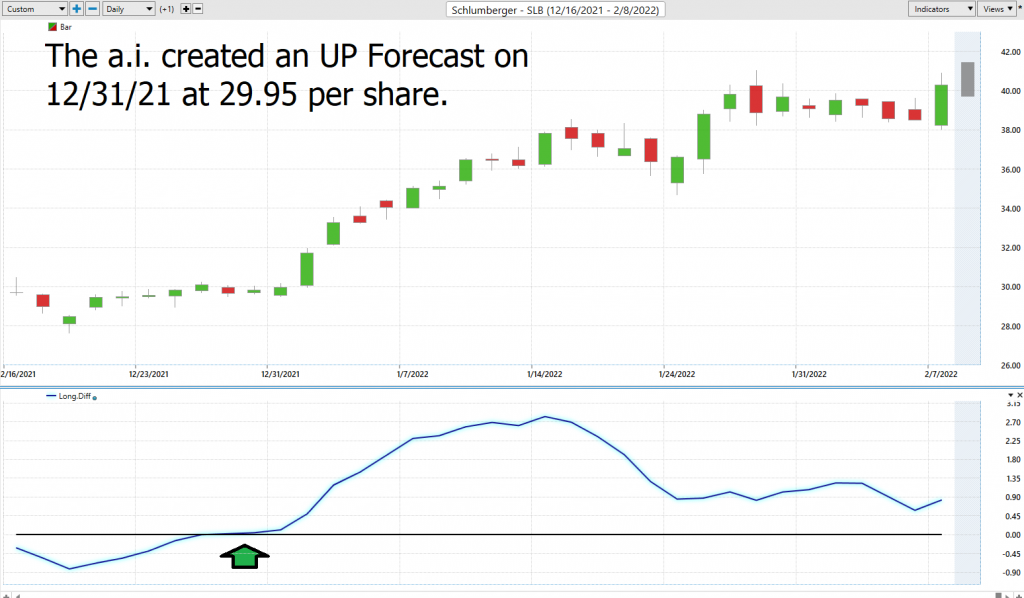
Whenever the predictive blue line moves below the black line, we are presented with a DOWN forecast. More importantly, there is no guesswork involved. Traders know where the value zone and trend is at all times. Since the UP forecast the market rallied as much as 37% in the last 5 weeks.
Fine Tuning Entries with The Neural Net Indicator
At the bottom of the chart is the Neural Network Indicator which predicts future strength and/or weakness in the market. When the Neural Net Indicator is green it communicates strength. When the Neural Net is red it’s forecasting short term weakness in the market.
We advocate that Power Traders cross reference the chart with the predictive blue line and neural network indicator to create optimal entry and exit points.
A Neural Net is a computational learning system that uses a network of functions to understand and translate massive amounts of data into a desired output, consistently monitoring itself and improving its performance.
Power Traders are always looking to apply both the neural network and A.I. to the markets to find statistically sound trading opportunities. We refer to this as a “double confirmation” setup and look for the predictive blue line to slope higher and to be confirmed by the Neural Net at the bottom of the chart.
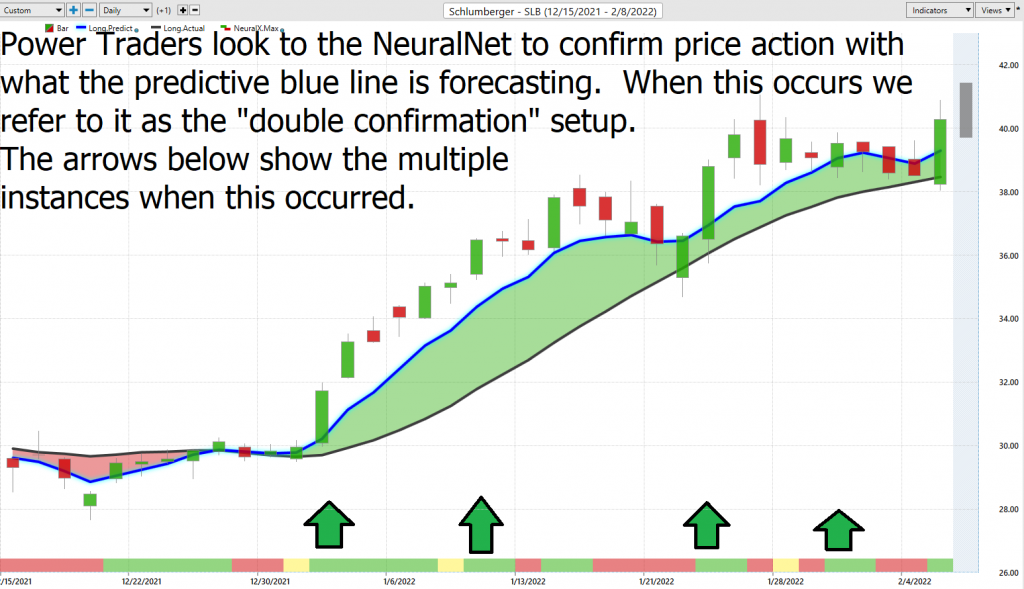
We advise Power Traders to cross reference the predictive blue line with the Neural Net for the best entry opportunities. Observe how the slope of the predictive blue line has remained positive from the time earnings were announced.
You can see in the chart above how the Neural Net offered several opportunities of double confirmation to Power Traders, when the predictive blue line and the Neural Net aligned with the same forecast. These instances provide very high probability trading opportunities to exploit the trend.
VantagePoint Software Daily Price Range Prediction
One of the powerful features in the Vantagepoint A.I. Software which Power Traders use daily is the Daily Price Range prediction forecast.
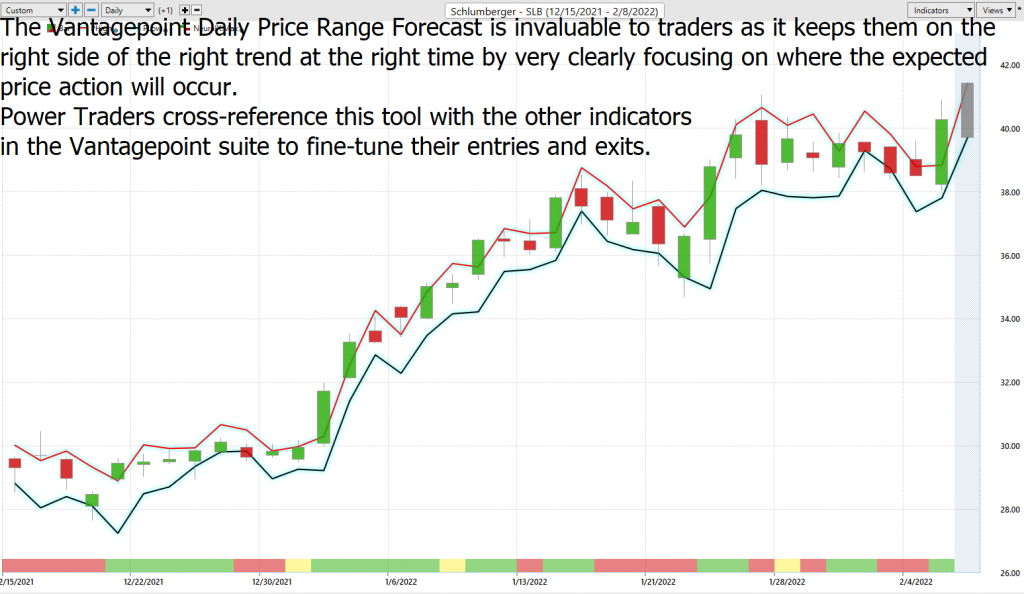
This forecast is what permits Power Traders to truly fine tune their entries and exits into the market.
What is the most important feature that traders are concerned about? Traders need to know where to enter and exit a market. VantagePoint provides this answer with exacting precision. Every day the Daily Range forecast is updated to provide insight to anticipated price action.
Bollinger Bands Analysis
A new feature to the stock of the week is our Bollinger Band Analysis. This indicator was created by Technical Analyst, CNBC commentator and Money Manager, John Bollinger in the 1980’s.
Bollinger Bands are composed of three lines. The middle line is usually a simple 20 day moving average. The upper and lower bands are computed by looking at the daily volatility of the asset and adding and subtracting twice that VOLATILITY value to the middle line.
Bollinger observed that the price of an asset congregated around its average (mean) and the outer limits of its price action were based upon the measure of volatility.
The indicators can be used in many different ways in rangebound and trending markets. However, one of its primary uses is to look at it as a mean reversion indicator. This idea is rooted in the premise that when price deviates too far from the mean it eventually reverts back to the mean price which is the middle line.
In trending markets, the outer bands help isolate overbought and oversold levels.
In the following chart observe how the middle line acts as a “value zone.” Once price consistently closes above the middle line it then moves to test the upper outer band. When it closes below the middle line it moves on to test the lower outer band. Bollinger Bands are a great tool for traders to use and cross-reference with the suite of Vantagepoint indicators.
Traders often will buy when the upper band is initially breached in anticipation of higher prices.
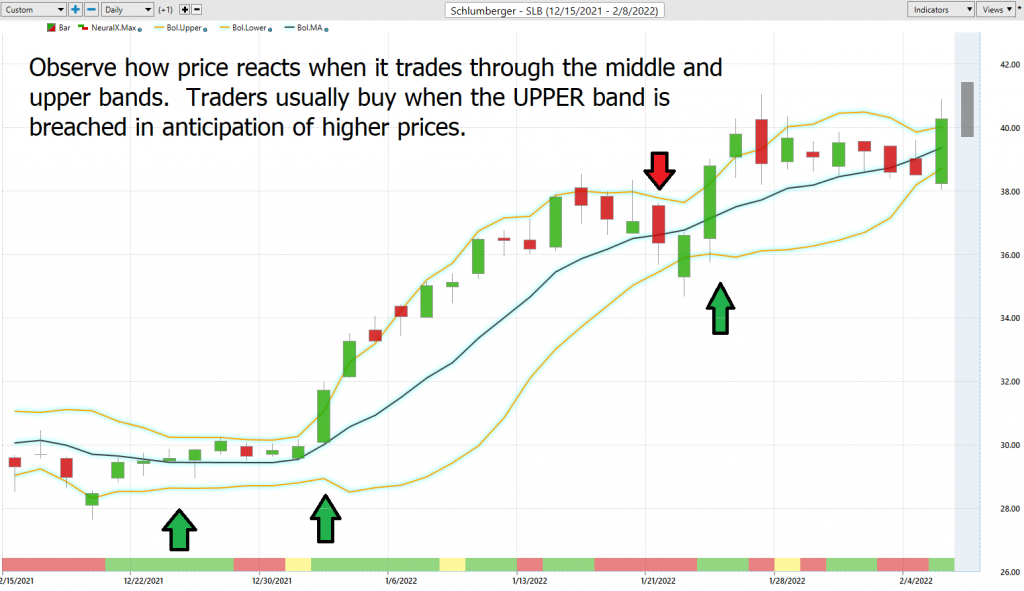
Intermarket Analysis
What makes the Vantagepoint Software extraordinary is its capacity to perform Intermarket analysis and to find those assets which are most statistically interconnected and are the key drivers of price.
Studying the charts can always provide objective realities in terms of locating support and resistance levels which become very clear on a chart. But we live in a global marketplace. Everything is interconnected. The billion-dollar question for traders is always what are the key drivers of price for the underlying asset that I am trading?
These intangibles are invisible to the naked eye yet show very high statistical correlations. Small changes in Interest rates, Crude Oil Prices, and the Volatility of the dollar amongst thousands of other variables affect the decisions companies must make to survive in these very challenging times. Trying to determine what these factors are is one of the huge problems facing investors and traders.
There is great value to be had in studying and understanding the key drivers of $SLB’s price action.
By doing so you can often see which ETFs are most likely acquiring $SLB as well as uncovering other industries which affect $SLB price movement.
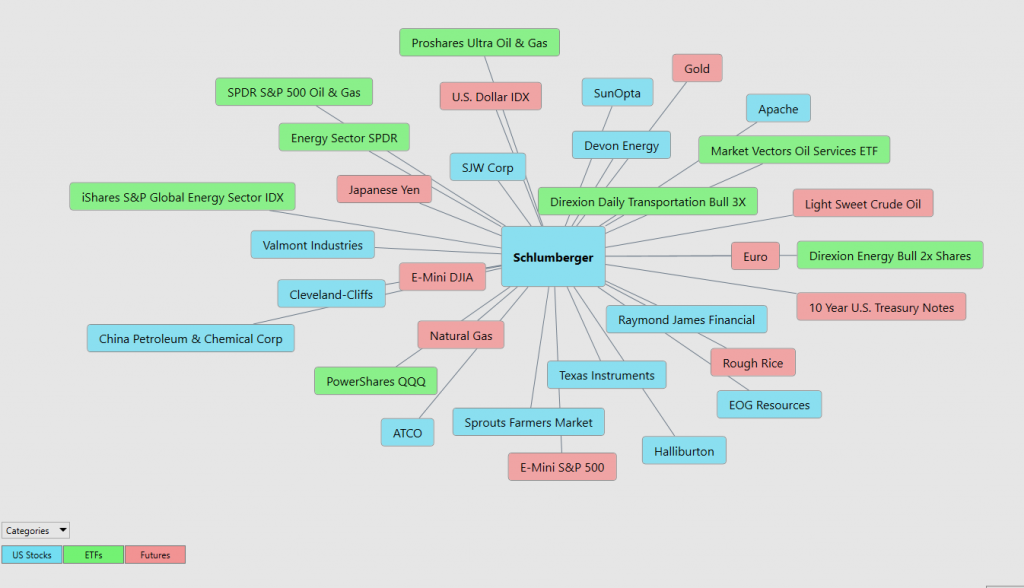
In the graphic above we can see the following ETF’s which are most highly correlated to $SLB price action:
- iShares S&P Global Energy Sector IDX
- Energy Sector SPDR
- SPDR S&P 500 Oil and Gas
- ProShares Oil and Gas
- Market Vectors Oil Services ETF
This can be invaluable information because it allows a trader to locate other opportunities and see a listing of the ETF’s that are also buyers of $SLB. This knowledge is how other trading opportunities are often uncovered in their embryonic stages.
Suggestion
The trend is in INFLATION and Oil is clearly UP.
Momentum is UP. The stock is still undervalued by Wall Street estimates. We think that in the coming 30 days Analysts will be upgrading their forecasts even further as Crude Oil continues its march higher.
However, make no mistake about it, this is a volatile asset. It is about 138% more volatile than the entire broad market. We should expect that pullbacks of 20% will be quite common in the coming months.
The performance metrics tell the entire story.

The reality that this stock has beat the performance handily of the S&P 500. Which is what keeps us anticipating even higher prices. As mentioned, one of the secrets to finding great investing or trading candidates is to focus on LEADERS who handily beat the broader market indexes. These assets are often few and far between and more volatile, but they offer great opportunities to buy on pullbacks.
Should the broader market continue with negative metrics we think the rotation into the oil and gas sector will be fast and furious. The yield chase will move to higher performing assets and away from the Dow Industrials should the broader indexes continue to correct. We think this trend has started and will continue.
Should the Fed follow through on its anticipated raising of interest rates we think $SLB will also be a longer-term beneficiary.
We like the idea of looking for buying opportunities of $SLB on dips and breaks which we expect to occur on a regular basis.
The predictive blue line is the guidance that we will be following. Simply look at the 10-year monthly chart to give you an idea of the potential upside should the rally in Crude Oil prices continue. Over the last 10 years $SLB has traded as high as $118.76 and as low as 12.17. With $SLB trading at $39 per share at present time we think it is still very much towards the bottom of its longer-term expected trading range.
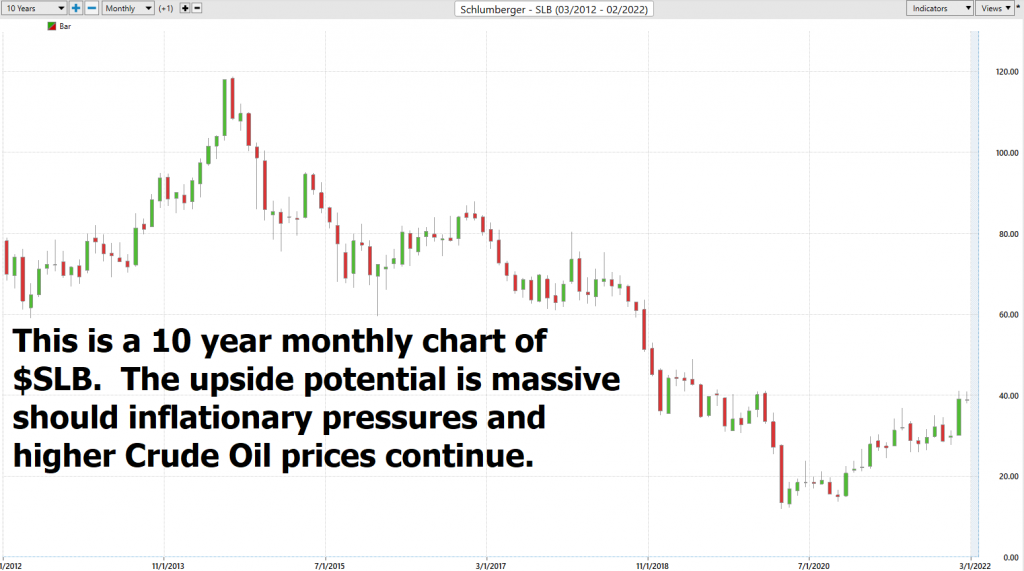
Our advice: Follow the a.i. trend analysis and practice good money management on all your trades. The chart looks very strong on $SLB. Inflationary pressures accompanied by supply chain issues will be very supportive to higher crude oil prices. This trend will benefit $SLB in a major way.
We will re-evaluate this analysis based upon:
- Wall Street Analysts’ Estimates
- 52-week high and low boundaries
- Vantagepoint A.I. Forecast (Predictive Blue Line)
- Neural Network Forecast
- Daily Range Forecast
- Bollinger Band analysis
- Intermarket Analysis
Let’s Be Careful Out There!
Remember, It’s Not Magic.
It’s Machine Learning.
IMPORTANT NOTICE!
THERE IS SUBSTANTIAL RISK OF LOSS ASSOCIATED WITH TRADING. ONLY RISK CAPITAL SHOULD BE USED TO TRADE. TRADING STOCKS, FUTURES, OPTIONS, FOREX, AND ETFs IS NOT SUITABLE FOR EVERYONE.
DISCLAIMER: STOCKS, FUTURES, OPTIONS, ETFs AND CURRENCY TRADING ALL HAVE LARGE POTENTIAL REWARDS, BUT THEY ALSO HAVE LARGE POTENTIAL RISK. YOU MUST BE AWARE OF THE RISKS AND BE WILLING TO ACCEPT THEM IN ORDER TO INVEST IN THESE MARKETS. DON’T TRADE WITH MONEY YOU CAN’T AFFORD TO LOSE. THIS ARTICLE AND WEBSITE IS NEITHER A SOLICITATION NOR AN OFFER TO BUY/SELL FUTURES, OPTIONS, STOCKS, OR CURRENCIES. NO REPRESENTATION IS BEING MADE THAT ANY ACCOUNT WILL OR IS LIKELY TO ACHIEVE PROFITS OR LOSSES SIMILAR TO THOSE DISCUSSED ON THIS ARTICLE OR WEBSITE. THE PAST PERFORMANCE OF ANY TRADING SYSTEM OR METHODOLOGY IS NOT NECESSARILY INDICATIVE OF FUTURE RESULTS. CFTC RULE 4.41 – HYPOTHETICAL OR SIMULATED PERFORMANCE RESULTS HAVE CERTAIN LIMITATIONS. UNLIKE AN ACTUAL PERFORMANCE RECORD, SIMULATED RESULTS DO NOT REPRESENT ACTUAL TRADING. ALSO, SINCE THE TRADES HAVE NOT BEEN EXECUTED, THE RESULTS MAY HAVE UNDER-OR-OVER COMPENSATED FOR THE IMPACT, IF ANY, OF CERTAIN MARKET FACTORS, SUCH AS LACK OF LIQUIDITY. SIMULATED TRADING PROGRAMS IN GENERAL ARE ALSO SUBJECT TO THE FACT THAT THEY ARE DESIGNED WITH THE BENEFIT OF HINDSIGHT. NO REPRESENTATION IS BEING MADE THAT ANY ACCOUNT WILL OR IS LIKELY TO ACHIEVE PROFIT OR LOSSES SIMILAR TO THOSE SHOWN.




